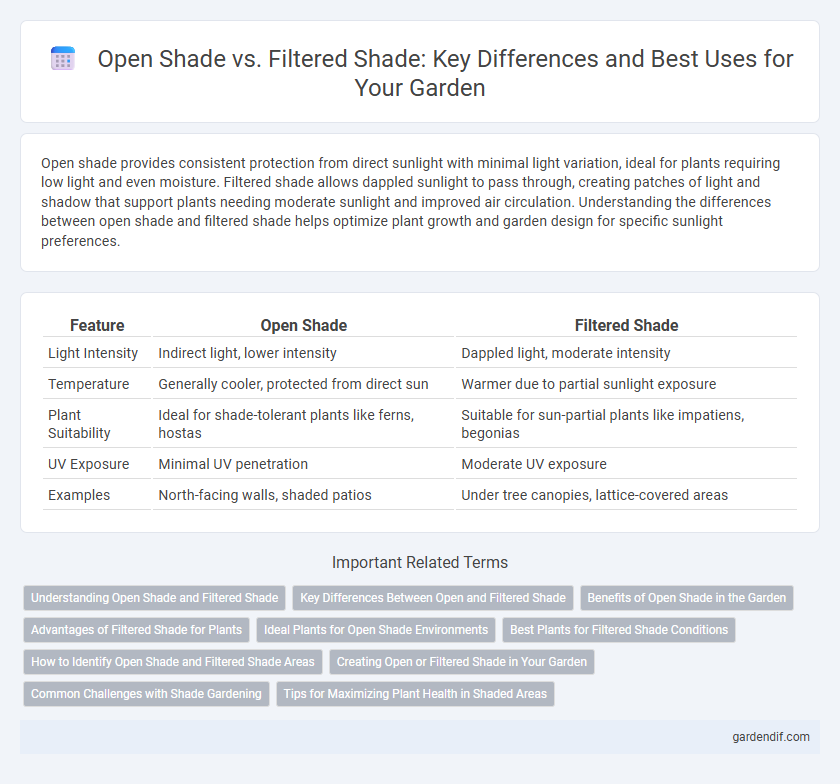
Open Shade vs Filtered Shade Illustration
Open shade provides consistent protection from direct sunlight with minimal light variation, ideal for plants requiring low light and even moisture. Filtered shade allows dappled sunlight to pass through, creating patches of light and shadow that support plants needing moderate sunlight and improved air circulation. Understanding the differences between open shade and filtered shade helps optimize plant growth and garden design for specific sunlight preferences.
Table of Comparison
| Feature | Open Shade | Filtered Shade |
|---|---|---|
| Light Intensity | Indirect light, lower intensity | Dappled light, moderate intensity |
| Temperature | Generally cooler, protected from direct sun | Warmer due to partial sunlight exposure |
| Plant Suitability | Ideal for shade-tolerant plants like ferns, hostas | Suitable for sun-partial plants like impatiens, begonias |
| UV Exposure | Minimal UV penetration | Moderate UV exposure |
| Examples | North-facing walls, shaded patios | Under tree canopies, lattice-covered areas |
Understanding Open Shade and Filtered Shade
Open shade refers to areas completely shaded by structures or objects such as buildings or fences, receiving indirect sunlight without any light filtering through foliage. Filtered shade occurs beneath tree canopies or shrubs where sunlight penetrates through leaves, creating dappled light with varying intensity and patterns. Understanding the differences between open shade and filtered shade is crucial for selecting appropriate plants, as some species thrive in consistent low-light conditions while others require partial sunlight.
Key Differences Between Open and Filtered Shade
Open shade occurs in areas exposed to indirect sunlight without obstruction, resulting in more diffused light and slightly higher temperatures compared to filtered shade. Filtered shade is created by sunlight passing through tree canopies or other semi-transparent barriers, producing dappled light with variable intensity and cooler microclimates. Plants in open shade generally require tolerance to low light and occasional sun exposure, while plants in filtered shade thrive with intermittent sunlight and moderate moisture levels.
Benefits of Open Shade in the Garden
Open shade provides consistent, indirect sunlight that promotes healthy plant growth by reducing the risk of leaf scorch and dehydration. It maintains cooler soil temperatures, preserving moisture levels which boost root development and plant resilience. This environment supports a diverse range of shade-tolerant crops and reduces the need for frequent watering, enhancing overall garden sustainability.
Advantages of Filtered Shade for Plants
Filtered shade provides plants with a gentle balance of sunlight, reducing the risk of leaf scorch and promoting healthier photosynthesis compared to open shade. This light condition allows optimal light diffusion, enhancing growth by supplying necessary light energy without intense heat stress. Plants under filtered shade typically exhibit improved color vibrancy and increased flowering due to consistent and moderate light exposure.
Ideal Plants for Open Shade Environments
Ideal plants for open shade environments include hostas, ferns, and astilbes, which thrive with limited direct sunlight and moderate moisture. These plants adapt well to dappled light beneath trees or next to buildings, maintaining vibrant foliage and consistent growth. Open shade areas benefit from species that tolerate partial sunlight, avoiding those requiring full shade or intense sun.
Best Plants for Filtered Shade Conditions
Filtered shade offers dappled sunlight ideal for many shade-loving plants like hostas, ferns, and astilbes, which thrive with indirect light and moderate moisture. Unlike open shade, where sunlight is nearly absent, filtered shade promotes healthier growth in plants requiring partial sunlight for photosynthesis. Gardeners should select species such as hellebores and caladiums that adapt well to the interplay of light and shadow typical in filtered shade environments.
How to Identify Open Shade and Filtered Shade Areas
Open shade areas are typically found where sunlight is blocked by large objects like buildings or walls, resulting in consistent, even shade throughout the day without direct sunlight. Filtered shade occurs under tree canopies or structures that allow dappled sunlight to pass through, causing varying patterns of light and shadow. Identifying these areas involves observing light intensity and shadow patterns during peak sunlight hours, noting whether the shade is uniform or mottled by partial light exposure.
Creating Open or Filtered Shade in Your Garden
Creating open or filtered shade in your garden involves selecting the right plants and structures to control sunlight exposure effectively. Open shade is typically achieved by planting deciduous trees with a high canopy that allows dappled sunlight, while filtered shade can be created using pergolas or shade sails combined with climbing plants or shrubs to diffuse direct sun. Proper placement enhances garden microclimates, promotes healthy plant growth, and provides comfortable outdoor living spaces.
Common Challenges with Shade Gardening
Open shade and filtered shade present distinct challenges for shade gardening, such as limited sunlight availability affecting plant photosynthesis and growth. Common issues include soil moisture retention problems, increased susceptibility to fungal diseases, and difficulty in selecting appropriate shade-tolerant plants. Managing these challenges requires careful plant selection, optimized watering schedules, and soil amendments to improve drainage and nutrient availability.
Tips for Maximizing Plant Health in Shaded Areas
Open shade, characterized by partial sunlight filtered through tree canopies, supports shade-tolerant plants by reducing direct sun exposure while allowing sufficient light for photosynthesis. Filtered shade provides dappled sunlight, creating ideal conditions for understory plants that thrive with intermittent light and cooler temperatures. To maximize plant health in shaded areas, select species adapted to low-light conditions, ensure adequate soil moisture through consistent watering, and incorporate organic mulch to retain soil nutrients and improve drainage.
Open Shade vs Filtered Shade Infographic

 gardendif.com
gardendif.com